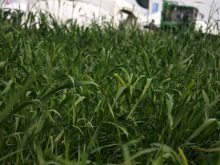Something bugging you?
Insects in stored grain, in particular rusty grain beetles, are a real concern for producers, especially those who binned damp or tough grain last fall.
The hardy beetle can survive after grain is dried, through transportation and on ships.
Apprehension from customers like Japan about chemical residues from fumigation prompted research into other types of control, said Chris Van Natto, senior technical manager at Hedley Technologies.
Hedley is promoting the use of diatomaceous earth, a stable non-toxic product already used in things like toothpaste and baby powder, and historically used by peasants to protect food.
Read Also

Ag in Motion shows four barley varieties on a single plot
Kui Liu, Agriculture and Agri-Food Canada research scientist, has been trialling a mix of barley varieties to address crop issues. A plot with this mix is on display at Ag in Motion 2025.
Applied as a dust
Diatomaceous earth is a natural absorbent formed when the shells of aquatic single-celled plants fell to the ocean floor and accumulated over thousands of years. It can be applied to grain as a dust or mixed with water to treat empty bins.
“All insects have a waxy covering,” Van Natto said. “(Diatomaceous earth) corrupts that covering and causes the insect to lose water.”
The water loss causes the insects to dehydrate and die.
Hedley’s product, Protect-It, is now available to producers in Canada. It is registered for use against rusty grain beetles in wheat only, at a rate of 100 grams per tonne.
“Rusty is the only insect that matters by virtue of its numbers,” Van Natto said. “It is very cold hardy. Maybe that’s why it’s more successful than other insects.”
Carbon dioxide used
In another control tactic, University of Manitoba researchers have perfected the use of carbon dioxide to kill bugs in hopper bins.
Department spokesperson Digvir Jayas said carbon dioxide suits customers who worry about chemical residue.
“Some of the buyers don’t want to buy grain treated with phosphine (a chemical insecticide used in gas form),” Jayas said. “It also satisfies the needs of organic growers.”
The department has been researching the use of carbon dioxide for more than 10 years, working to overcome the problem of bins that are less than airtight. Two Manitoba farmers have used it as part of the research, Jayas said.
“Now we can say, ‘Yes, the technology works. We have demonstrated it using full-size bins’ ,” he said.
Testing is also being done on concrete bins and the next step is rail cars.
“Seven or eight of our graduate students are doing their theses on the research,” Jayas said.
The drawback to carbon dioxide is that it works slower than chemicals, however all methods’ effectiveness depends on temperature and grain moisture. Jayas said it takes about 10 days, compared with seven days for phosphine (including three days of aeration afterward.)
Diatomaceous earth takes 10 days to work at the recommended rate.
The two are comparable in cost at about five cents per bushel, but that varies depending on how well the bin is sealed.
Diatomaceous earth is cheaper at about 2.6 cents per bushel, Van Natto said. The cost of treating an empty bin is 0.2 to 0.3 cents per bushel of capacity.
The product does lower test weight in high doses and can affect how grain flows. The owner is responsible to make sure wheat will not be downgraded because of low test weight.
Both Van Natto and Jayas said their methods of control can be done by farmers themselves, without calling in applicators.
“It comes down to preservation of grain quality, and grain quality of the farm rather than having the elevator do it for them,” Van Natto said.

















